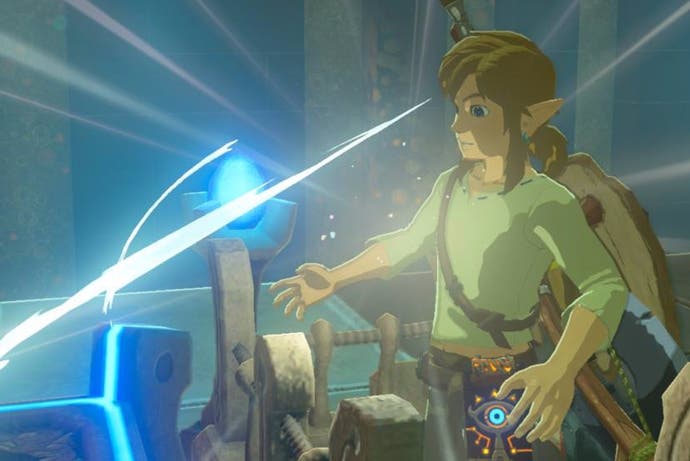So much of the magic of Zelda's reinvention is visible in this single shrine
Duh-duh-duh-DUUUUUUH!
Yes, I am late to the new Zelda, but I am playing now and catching up on the sense of wonder and discovery that everybody else experienced back at the start of the year. I've just finished the fourth shrine in the Great Plateau region - for me it was the Owa Daim Shrine, where you undergo the Stasis Trial - and I realised that everything that is so new and startling, and yet so harmonious and deeply right about this new Zelda is present in microcosm in this single puzzle chamber. Oh, and I discovered the screenshot button too. So let's take a look, eh?
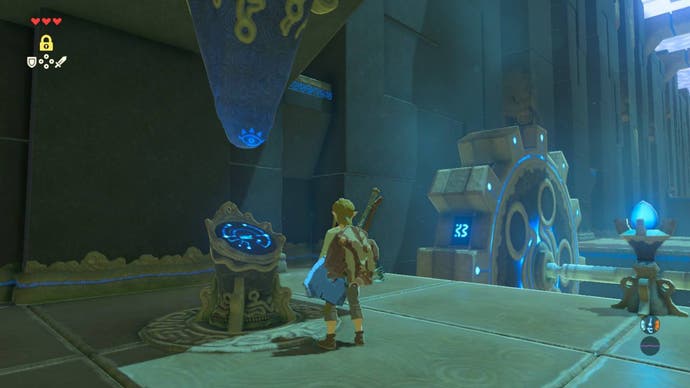
Magic, nature, and technology
Man, Breath of the Wild's relationship with technology is fascinating. The Sheikah Slate you're given at the start of the game is clearly magical, but it's also clearly technology. It boots up, it has its own UI, and when you slot it into docks scattered around the environment it talks about 'authenticating' and all that Silicon Valley jazz. It would be easy enough to say that it's an example of Clarke's third law - that any sufficiently advanced technology is indistinguishable from magic - but then when you dock it in one of the game's first four shrines, you see it's a bit more complicated than that.
The docking station sits under stalactite that seems to have formed naturally. When the slate is downloading new information, this stalactite suddenly blossoms with lines of scrolling code. But the code is then delivered into the slate via a single droplet of dew that forms at the end of the stalactite. Magic, nature and technology come together: how brilliant.
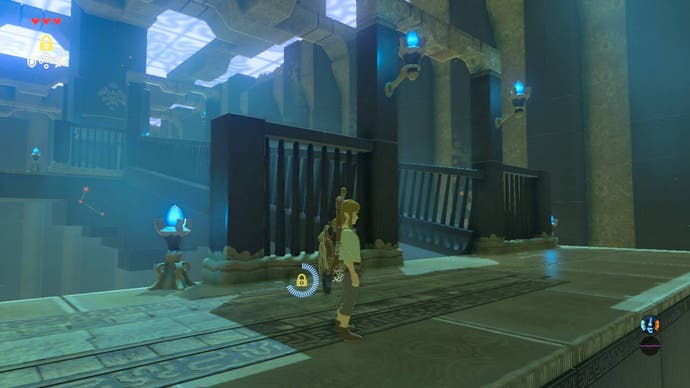
The puzzle
Each shrine contains a puzzle, and the first few are there to introduce the specific powers that you are granted by docking your slate at the start of the shrine. In the Owa Daim Shrine, you're learning about time manipulation - the ability to freeze time in terms of certain objects and conserve their momentum.
It's a classic example of Nintendo's four-stage approach to puzzle creation, known as Kishōtenketsu. Smarter people than me have spoken about this at length, but the idea is that an idea is introduced, developed, twisted and then concluded in the space of a few minutes. In the Owa Daim Shrine, the first two stages break down quite simply. The idea is introduced with a spinning platform that has a cog you can pause when the platform is horizontal, so that you can cross a gap. The gap is fairly narrow and there's no real danger. I say that, but I fell of course, because I am all thumbs and an idiot, but you're not meant to fall, and I should feel bad. (I do.)
Next up is a ramp with a rolling boulder. The idea's simple again, but there are a couple of things that are quite cool about this one. The danger is knocked up a notch: there are two ramps for the boulder to cross, and if you're impatient, you're going to get flattened. There's also this chest at the very top, clearly optional, but tempting you to take an additional risk
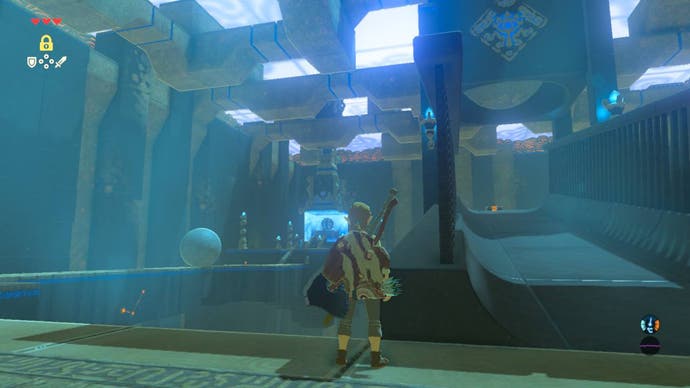
But that's not all. One of the things I think is super cool about this shrine is the way that the layout of the landscape works with the cooldown on your powers. You need to wait for your time-freezing power to recharge, and that means that you pretty much need to stop and watch the interval of the boulders coming down the ramp. Nintendo's forcing you to notice the things that are important, but doing it without breaking into the moment at all. It's all within the mechanics.
Also, the visual metaphor is just lovely. These chains don't just say that time is frozen, they also suggest that great forces are being held in check - for now.

And this brings us to the third stage of the puzzle. The twist. The spinning platform introduced everything, the ramp developed it by adding danger and an optional risk, and now the third challenge is where Nintendo really blows my mind. When the time-freezing tool is introduced I'm told that this form of magic will conserve an object's momentum - or words to that effect; I was getting a Pop-Tart. That didn't make much of an impact at the time. I am quite stupid, and it seemed a bit over my head. But here's the third challenge with a boulder blocking my path.
I've just been given a hammer, so I try whacking the boulder. Nothing. Then I try freezing the boulder in time. Still nothing. But when I freeze the boulder and whack it, an arrow starts to emerge from the boulder. Suddenly I get it: the boulder, while frozen, will conserve any momentum, so I can basically store it up while time is paused, and then pay it all off at once when time returns to normal. Time unfreezes, the boulder blasts out of the way, and I am left with the realisation that time manipulation in this game is going to be a proper head-f***. Amazing! And with that, stage four of Kishōtenketsu has been achieved.
But there is still more to this shrine...
Character
The shot below is of my favourite animation in the game so far: I never tire of watching it. At the end of the Shrine, you are given a mystical token of some kind. I have been given loads of mystical tokens over my years playing games, but this one is different, because look at the way Link reacts to it:
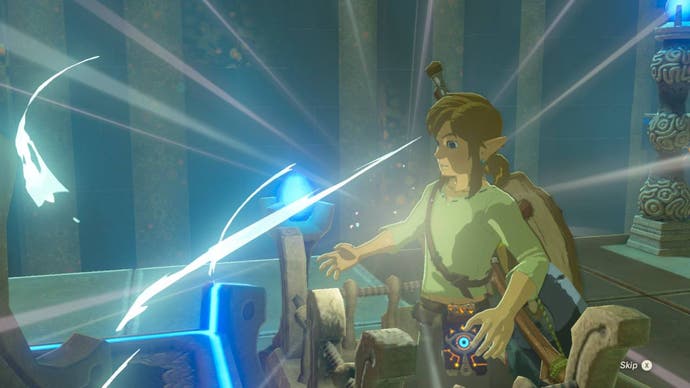
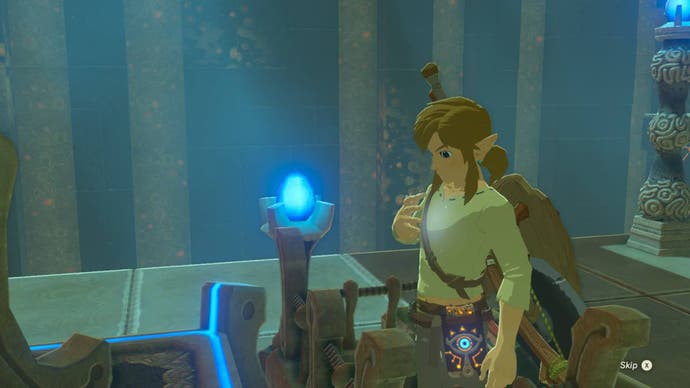
As the token sort of dissolves into him, his expression is just wonderful: he is not afraid, as such, but he is fighting a little initial alarm, I think. And then he's just trying to parse the experience. What did that feel like? It seems to me that he is reacting as if he's tasted something unusual for the first time and is trying to understand the sensations.
Link is often seen as being a blank slate, but that isn't true and this animation is a reminder of that. There is a lot of space there for the player to fill in the details of his character, just as in the old games you could give him a different name if you were some kind of a monster. But there is a core of Link that remains unchanging. His kindness and bravery, sure, but also this: his sense of wonder, and his fascination with new experiences. All of this, unmistakably delivered, in one of the more subtle pieces of animation I have ever witnessed in a game.
Finally
Since this shrine was my last on the plateau, once I get outside I am met by the mysterious old man who has been guiding me so far. He announces that the time has come to tell me everything. But he doesn't tell me now. He wants to meet me somewhere, but he doesn't tell me exactly where.
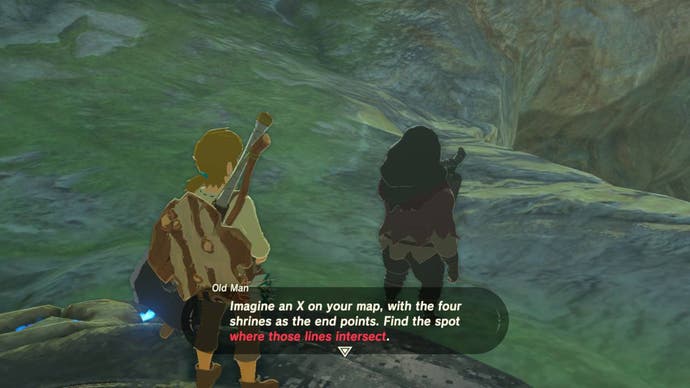
Or at least he doesn't in the way that most games do. Most games would whack a new point of interest on the map. But Breath of the Wild doesn't work that way, and this is perhaps why even the tutorial plateau that takes up the game's first hour feels like such an adventure. You're told what you should do - visit the four shrines - but you're never told how to do that. You are left to make your own way to each one, and as you do you'll be organically learning about item durability, combat, fire propagation, the day/night cycle, and the importance of maintaining your temperature during cold spells. I've just come off the back of Rise of the Tomb Raider, which is an exciting game at times, but very rarely an adventure, and that's because it has this magic button I can press that highlights any objects of interest, and also tells me where to go next. And I can do this all the time. In Zelda, there is no magic button. Tomb Raider would have marked the four shrines on my hud for me. In Zelda, I had to climb a tower and find them myself. And now, the old man isn't telling me where to meet him, he's telling me how to find the spot where I will meet him - where lines drawn between the shrines intersect.
So he's giving me my next objective, handing me a challenge, and also encouraging me to consider a hidden sense of order within the landscape. What a beautiful thing. What an astonishing game. And this is, really, just the tutorial.
